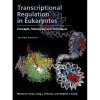![Transcriptional Regulation in Eukaryotes Transcriptional Regulation in Eukaryotes]()
Click to have a closer look
About this book
Contents
Customer reviews
Related titles
About this book
Strategies for studying gene regulation mechanisms have changed dramatically over the past several years in light of the emergence of complete genome sequences for many organisms as well as the development of or improvements to technologies such as chromatin immunoprecipitation, RNA interference, microarrays, and proteomics.
The first edition of the highly successful Transcriptional Regulation in Eukaryotes, written by Michael Carey and Stephen Smale at UCLA, provided a comprehensive source of strategic, conceptual, and technical information for investigating the complexities of gene regulation at the level of transcription.
With the ever-increasing importance of genome data and the appearance of new and better techniques, the second edition of this book has added a third author, Craig Peterson at the University of Massachusetts Medical School. In addition to a new chapter on the in vitro analysis of chromatin templates for DNA-binding studies and transcription, this second edition has been extensively rewritten and updated to discuss new advances in the field and their impact on gene regulation mechanisms. The second edition retains the approach of the first in covering both the conceptual and practical aspects of how to study the regulation of a newly isolated gene and the biochemistry of a new transcription factor.
Transcriptional Regulation in Eukaryotes serves as both a powerful textbook and manual for advanced instruction in molecular biology which
- supplements clearly written text with extensive illustrations
- puts methods in the context of underlying theory
- gives expert recommendations on experimental strategies
- encourages creativity in investigative design
- explains protocols for essential techniques step by step, with extensive advice on troubleshooting
- provides the latest methods in use in the field
This important and unique book is essential reading for anyone pursuing the analysis of gene expression in model systems or disease states, providing underlying theory and perspective to the newcomer and the latest techniques to the expert.
Contents
Preface
Overview
Abbreviations and Acronyms
1. A Primer on Transcriptional Regulation in Mammalian Cells
2. Initial Strategic Issues
3. Transcription Initiation Site Mapping
4. Functional Assays for Promoter Analysis
5. Identification and Analysis of Distant Control Regions
6. Identifying cis-Acting DNA Elements within a Control Region
7. Identification of DNA-Binding Proteins and Their Genes
8. Confirming the Functional Importance of a Protein-DNA Interaction
9. In Vivo Analysis of an Endogenous Control Region
10. Identifying and Characterizing Domains of Transcription Regulatory Factors
11. DNA Binding by Regulatory Transcription Factors
12. Transcription and Preinitiation Complex Assembly In Vitro
13. Studying Chromatin Dynamics In Vitro: Chromatin Assembly, Remodeling, and Transcription
Appendix: Cautions
Index
Customer Reviews


































